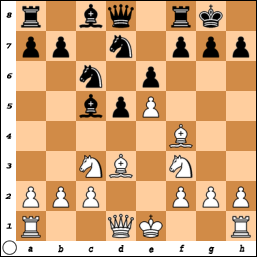MY disappointing recent form for Battersea continued last night when I lost for the second team against Athenaeum 2 in division three of the London League.
The result means I have lost seven of my last 10 outings for the club, but at least the game had several instructive moments.
Ti Chen (169) - Spanton (171)
London System
1.d4 d5 2.Nf3 e6
This anticipation of White's next has been played by Kasparov, Anand and So.
3.Bf4 Bd6 4.Bg5?
This is simply a loss of tempo.
4...f6
Rather surprisingly the most popular move in ChessBase's 2019 Mega database is to give the tempo back with 4...Be7? Possible, however, is 4...Nf6, when Black is a tempo up on the Torre Attack.
5.Bh4 Nh6?!
This will come to the same thing as the more flexible 5...Ne7
if Black goes after White's light-square bishop, but it is not clear this is Black's best plan.
6.e3 Nf5 7.c4!?
White cannot save his bishop-pair but 7.Bg3 was the obvious move so 7...Nxg3 8.hxg3 would give White a half-open h file. But the text is an interesting choice in that White is arguing Black's win of the bishop-pair is costing valuable tempi.
7...Nxh4 8.Nxh4 Qd7
Stockfish10 and Komodo9 prefer 8...0-0, which I hardly even considered, thinking it to be castling into a White attack.
9.c5 Bf8
The engines give 9...Be7!? intending to meet 10.Qh5+ with 10...Kd8, a position they assess as equal.
10.Qh5+?!
The engines much prefer 10.Nc3.
10...Qf7 11.Qxf7+ Kxf7 12.Nc3 Bd7 13.b4 b6 14.Nb5?
 |
| A critical moment - how should Black exploit White's last move? |
*****
*****
*****
*****
*****
14...Bxb5
Black is still better after this but best was 14...a6! when 15.Nxc7 loses to 15...Ra7, and the ignominious retreat 15.Nc3 is well met by 15...a5, collapsing White's queenside.
15.Bxb5 c6 16.Bd3 Nd7?
I rejected 16...a5 because after 17.cxb6 Bxb4+ 18.Ke2 Black's pieces are a little uncoordinated. The engines give 18...Nd7 19.b7 Ra7 20.Rhc1 Rxb7 21.Rxc6 with equality.
This would have been better for Black than the text but is irrelevant in that Black has a major improvement in this line with 17...axb4! The half-open a file makes all the difference, eg one line given by the engines runs 18.Ke2 Nd7 19.Rhc1 Nxb6 (19...c5 is also good) 20.Rxc6 Na4 with a lovely outpost for the knight at c3.
17.e4!?
An interesting attempt to seize the initiative.
17...g5!?
At first the engines reckon 17...a5 leaves Black much better, but they come to see virtues in White's position after 18.exd5.
18.Nf3 Bg7?
The bishop has few prospects on the long dark diagonal. I thought there were latent threats to d4 and through it to the a1 rook, but instead my bishop becomes entombed.
19.exd5 exd5 20.0-0 h5 21.Rac1?
A waste of time. Simple and good was the immediate 21.Bf5.
21...b5 22.Bf5 Rhd8
This move would have been problematic after 21.Bf5 thanks to the reply 22.b5! But now it keeps Black in the game, although White is much better - just compare the bishops!
23.Rfe1
The engines prefer adding queenside pressure with 23.a4.
23...Nf8 24.g4
Again the engines prefer a4.
24...h4?
I rejected 24...hxg4 because of 25.Bxg4 with Bh5+ to follow, but 25...a5 gives Black sufficient counterplay as White's invasion down the e file turns out to be no more dangerous than Black's down the a file.
25.Re3 Re8 26.Rce1
I was more concerned about 26.Ra3, forcing 26...a6, but perhaps Black is holding. The engines like 26.a4, with White much better after 26...a6 or 26...bxa4, in each case met by 27.Ra1.
26...Rxe3 27.fxe3!
White hopes to get his central-queenside pawns rolling while Black's three kingside pawns are held up by White's two pawns and the marvellously placed light-square bishop.
27...Ne6?
Counterplay with ...a5 was still the best chance, but 28.e4 keeps White on top.
28.e4 Nf4!?
Black is lost whatever he plays, according to the engines, but the text at least gives the prospect of counterplay if White slips up.
29.e5?
And he does immediately. This is very much the wrong idea. Black is pretty much helpless after 29.Bd7 or 29.exd5.
29...a5
White's central-queenside play is over, so Black is at least equal.
30.a4?
White should have settled for passive defence with 30.a3 axb4 31.axb4 Ra4 32.Rb1.
30...axb4?
Winning is 30...bxa4. I rejected it because of 31.b5, but then comes 31...cxb5, when 32.c6 fails to 32...Ra7 or even 32...a3!?
31.axb5 Ra2?
If this attack against White's king does not work, it is just a waste of time, and it definitely does not work. Correct was 31...cxb5 32.c6 Ra7 with equality.
32.Kf1?
There is no mating attack, or even a draw by repetition, so White should have got on with it on the queenside, winning with 32.bxc6 or 32.b6, eg 32.bxc6 Nh3+ 33.Kh1 Nf2+ 34.Kg2! Nd3+ 35.Kf1 Nxe1 36.c7 Ra8 37.Ke1 etc.
32...Nh3?
There was still a draw to be had by ...cxb5.
33.Re2 Ra1+ 34.Ne1 cxb5
Too late.
35.c6 Ra7 36.Rc2 Rc7 37.Nd3
Even stronger was 37.e6+!, obliging Black to further block his bishop with 37...Ke7 or to retreat the king to the back rank.
37...fxe5??
There was still hope in 37...Bf8, eg 38.Bd7 Nf4! 39.Nxf4 gxf4 40.Kf2 fxe5 41.dxe5 Bg7 (analysis by the engines) - Black is a (doubled) pawn up, but the position of his rook means White is effectively playing with the advantage of the exchange.
38.Nxb4 exd4 39.Nxd5 Be5 40.Nxc7
The remaining moves were:
40...Bxc7 41.Rc5 Nf4 42.Rxb5 Ke7 43.Rb4 Kd6 44.Be4 Kc5 45.Rb7 Kd6 46.Rb5 Bd8 47.Rb8 Kc7? 48.Rb7+ 1-0
Updated statistics Battersea 2018-19
Event...Colour...Grade...Opponent's Grade...Result
CLL........B..........167...….........196...............…D
LL...…….B...…...167...………..159...………….D
CLL...…..B...…...167...………..161...………….W
CLL...…..B...…...167...………..190...………….D
LL...…….W...…..167...………..161...….………W
CLL...…..W...…..167...………..148...………….D
CLL...…..W...…..167...………..165...………….W
CLL...…..W...…..167...………..160...………….D
CLL...…..W...…..167...………..159...………….D
LL...…….B...…...167...………..168...………….D
LL...…….W...…..171...………..159...………….W
CLL...…..B...…...171...………..198...……….….L
CLL...…..B...…...171...………..169...…………..L
CLL...…..B...…...171...………..196...…………..L
LL...…….B...…...171...………..182...…………..D
CLL...…..W...…..171...………..189...…………..L
LL...…….B...…...171...………..178...…………..L
CLL...…..B...…...171...………..164...…………..D
LL...…….B...…...171...………..188...………….W
CLL...…..B...…...171...………..200...…………..L
LL...…….B...…...171...………..169...…………..L
Overall this season for Battersea I have scored +5=9-7 for a grading performance of 170.
In season 2017-18 I scored +10=8-9 for a grading performance of 175.






















